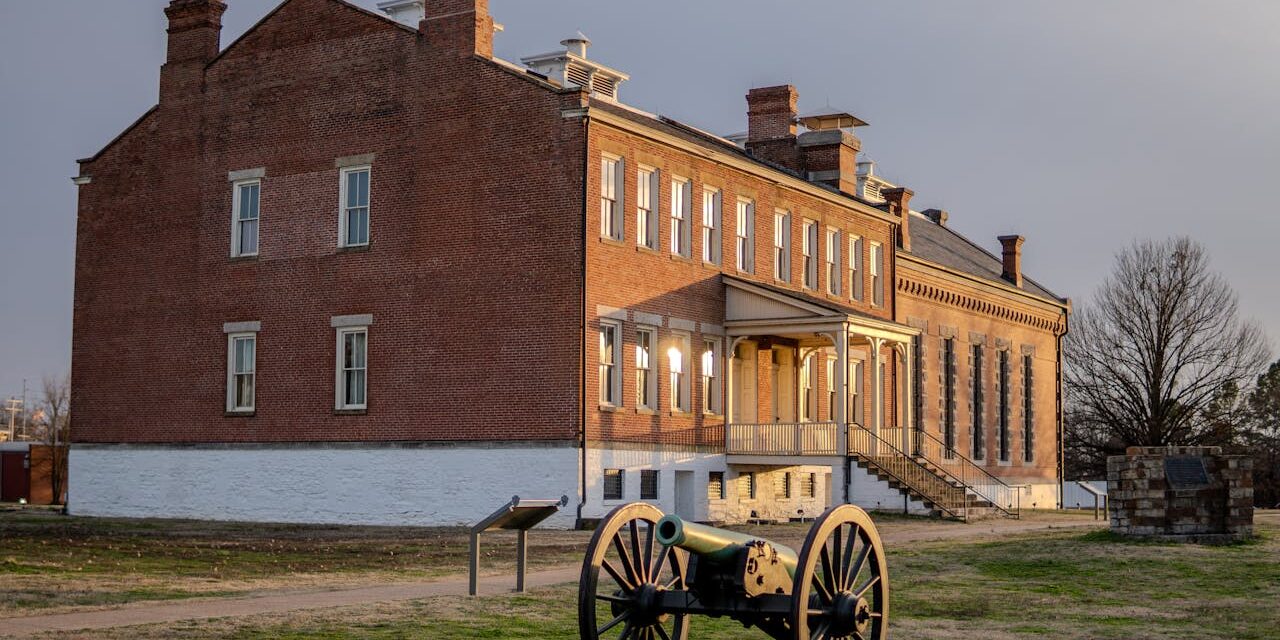The state of Arkansas has a diverse and storied history, characterized by its rich cultural heritage and significant events that have shaped its development.
From its early indigenous roots and European settlement to its role in the Civil War and civil rights movement, Arkansas’s history is resilient and transformed.
Below, we explore Arkansas’s fascinating history, covering its foundation, key historical events, and notable landmarks.
Table of Contents
Early History
Indigenous Inhabitants and European Exploration
Before European settlers arrived, Arkansas was inhabited by various Native American tribes, including the Quapaw, Osage, and Caddo.
- These tribes had established societies with rich cultures, agriculture, and trade networks.
- European exploration began and started in the 16th century with Spanish explorers like Hernando de Soto.
The indigenous peoples and early European explorers laid the groundwork for future settlements.
French and Spanish Periods
France first claimed Arkansas as part of the Louisiana Territory.
- The French established trading posts, including the Arkansas Post, in 1686, which became a significant settlement.
- After the French and Indian War, this is when the territory was ceded to Spain, but it was later returned to France before being sold over to the United States in the Louisiana Purchase of 1803.
Arkansas’s early economy was based on fur trading and agriculture.
19th Century Development
Territorial Period and Statehood
The Arkansas Territory was established in 1819, separating from the Missouri Territory.
- The territory experienced rapid growth, with settlers attracted by the fertile and good land and opportunities for agriculture.
- Arkansas was admitted and allowed into the Union as the next and 25th state on June 15, 1836.
By the mid-19th century, Arkansas was a developing state with a growing population and economy.
Civil War and Reconstruction
Arkansas seceded away from the Union on May 6, 1861, joining the Confederate States.
- The state played a significant role in the Civil War, with crucial battles such as the Battle of Pea Ridge, as well as the Battle of Prairie Grove.
- After the war, Arkansas underwent Reconstruction, facing significant social and economic changes.
The Reconstruction era saw efforts to rebuild the state’s economy and integrate formerly enslaved people into society.
Post-Reconstruction and the Jim Crow Era
The post-Reconstruction period was marked by the implementation of Jim Crow laws, which enforced and allowed racial segregation and disenfranchised African Americans.
- The agricultural economy continued to dominate, with cotton as the primary crop.
- The late 19th and early 20th centuries saw economic diversification with the growth of industries such as timber and mining.
By the early 20th century, Arkansas was in transition, facing challenges and opportunities.
20th Century and Modern Era
Economic and Social Development
The early 20th century brought significant economic and social changes to Arkansas.
- The state’s economy diversified further with the development of manufacturing and transportation industries.
- The Great Depression had a severe impact, but New Deal programs helped to mitigate some of the economic hardships.
Post-World War II, Arkansas saw rapid urbanization and modernization.
The Civil Rights Movement
Arkansas played a pivotal and very central role in the Civil Rights Movement, particularly with the integration of Central High School in Little Rock in 1957.
- The Little Rock Nine, a group of African American students, faced intense opposition when they attempted to attend the previously all-white school.
- Federal intervention was required to enforce desegregation and protect the students.
The events in Little Rock were crucial in the national struggle for civil rights and equality.
Notable Landmarks
Hot Springs National Park
Hot Springs National Park, established in 1832, is one of the oldest federal reserves in the United States.
- The park is known for its thermal springs, which have been used for therapeutic purposes for centuries.
- It features historic bathhouses and scenic trails.
Hot Springs National Park highlights Arkansas’s natural beauty and historical significance.
Little Rock Central High School
This historic site commemorates the integration crisis of 1957 and the bravery of the Little Rock Nine.
- The school is still operational and serves as a symbol of the fight and hard work to gain civil rights.
- The visitor center offers exhibits and delivers educational programs about the events.
Little Rock Central High School is a powerful reminder of the struggles and progress in civil rights.
Crater of Diamonds State Park
Located in Murfreesboro, this park is the only diamond-producing site open to the whole public.
- Visitors can look and search for diamonds and other gemstones and keep what they find.
- The park also offers a museum and interpretive programs.
Crater of Diamonds State Park is a very unique attraction highlighting Arkansas’s geological diversity.
Governance
State Government
Arkansas operates under a constitution adopted in 1874.
- The state government consists of the Executive, Legislative, and Judicial branches.
- The governor, currently Sarah Huckabee Sanders, leads the executive branch.
The state government works to address the needs of its diverse population and manage its resources effectively.
Local Government
Arkansas’s local government structure includes counties, cities, and special districts.
- Each level of government has specific responsibilities for services such as education, public safety, and infrastructure.
- Local governance ensures that the diverse needs of Arkansas’s communities are met.
Effective local governance contributes to the overall well-being of the state’s residents.
Demographics and Growth
Population
As of 2023, Arkansas’s population was approximately 3.04 million. The state’s demographic makeup reflects its history of immigration and cultural diversity.
Diverse demographics and steady growth reflect Arkansas’s appeal as a place to live and work.
Education and Economy
Arkansas is home to several prominent educational institutions, including the University of Arkansas and Arkansas State University.
- The state’s economy is diverse, with key sectors including agriculture, manufacturing, and services.
- Arkansas is also known for being the headquarters of Walmart, the world’s largest retailer.
These factors contribute to the state’s economic resilience and cultural vibrancy.
State of Arkansas Q&A
Q: When was Arkansas admitted to the Union?
A: Arkansas was admitted to the Union as the 25th state on June 15, 1836.
Q: Who were the original inhabitants of Arkansas?
A: The original inhabitants of Arkansas were various Native American tribes, including the Quapaw, Osage, and Caddo. These tribes had established societies with rich cultures, agriculture, and trade networks.
Q: What role did Arkansas play during the Civil War?
A: Arkansas seceded from the Union on May 6, 1861, and joined the Confederate States. The state was the site of key battles, such as the Battle of Pea Ridge, as well as the Battle of Prairie Grove.
Q: How did Arkansas contribute to the Civil Rights Movement?
A: Arkansas played a pivotal role in the Civil Rights Movement, particularly with the integration of Central High School in Little Rock in 1957. The Little Rock Nine faced intense opposition, and federal intervention was required to enforce desegregation.
Q: What are some notable historical landmarks in Arkansas?
A: Notable landmarks include Hot Springs National Park, Little Rock Central High School, and Crater of Diamonds State Park. These sites highlight Arkansas’s natural beauty, civil rights history, and geological diversity.
Q: How is Arkansas governed?
A: Arkansas operates under a constitution adopted in 1874, with an Executive, Legislative, and Judicial branch. The governor leads the executive branch, and counties, cities, and special districts manage local governance.
Q: What is Arkansas’s current population?
A: As of 2023, Arkansas’s population was approximately 3.04 million. The state continues to attract residents with its diverse culture, educational opportunities, and economic resilience.
Arkansas’s dynamic history and commitment to preserving its natural and cultural heritage make it a unique and vibrant state.
By maintaining its historical landmarks and fostering growth in new industries, Arkansas continues to honor its past while looking forward to a prosperous future.





